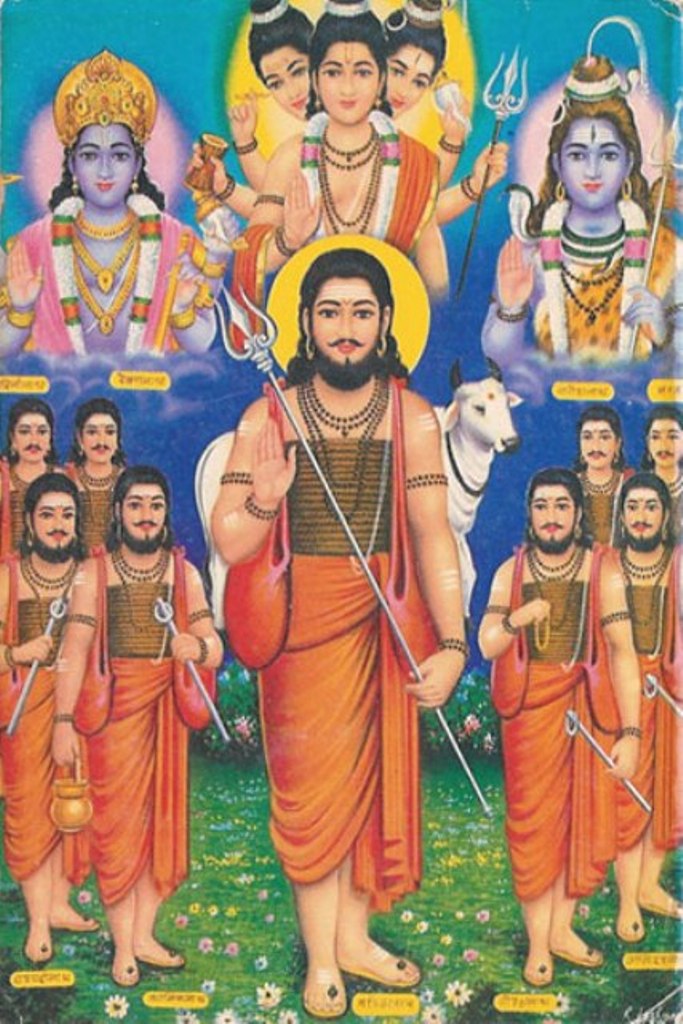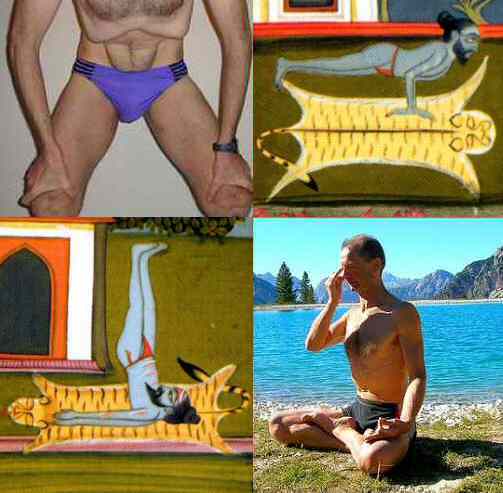|
Matsyendranatha
Matsyendranātha, also known as Matsyendra, Macchindranāth, Mīnanātha and Minapa (early 10th century) was a saint and yogi in a number of Buddhism, Buddhist and Hinduism, Hindu traditions. He is considered the revivalist of hatha yoga as well as the author of some of its earliest texts. He is also seen as the founder of the natha ''sampradaya'', having received the teachings from Shiva. He is associated with Kaula (Hinduism), Kaula Shaivism. He is also one of the eighty-four mahasiddhas and considered the guru of Gorakshanath, another known figure in early hatha yoga. He is revered by both Hindus and Buddhists and is sometimes regarded as an incarnation of Avalokiteśvara. In the Siddhar tradition of Tamil Nadu, Matsyendranath is revered as one of the 18 Siddhars of yore, and is also known as Machamuni. The Kasi Viswanathar Temple in Thiruparankundram, Madurai, Tamil Nadu is home to his Jiva, Jeeva Samadhi. Early life Little is known about the life of Matsyendra: he is also ... [...More Info...] [...Related Items...] OR: [Wikipedia] [Google] [Baidu] |
Natha
Natha, also called Nath (), are a Shaivism, Shaiva sub-tradition within Hinduism in India and Nepal. A medieval movement, it combined ideas from Buddhism, Shaivism, Tantra and Yoga traditions of the Indian subcontinent.Natha: Indian religious sect Encyclopedia Britannica (2007) The Naths have been a confederation of devotees who consider Shiva as their first lord or guru, with varying lists of additional gurus. Of these, the 9th or 10th century Matsyendranatha and the ideas and organization mainly developed by Gorakhnath are particularly important. Gorakhnath is considered the originator of the Nath Panth. The Nath tradition has an extensive Shaivism-related theological literature of its own, most of which is ... [...More Info...] [...Related Items...] OR: [Wikipedia] [Google] [Baidu] |
Hatha Yoga
Hatha yoga (; Sanskrit हठयोग, International Alphabet of Sanskrit Transliteration, IAST: ''haṭhayoga'') is a branch of yoga that uses physical techniques to try to preserve and channel vital force or energy. The Sanskrit word हठ ''haṭha'' literally means "force", alluding to a system of physical techniques. Some hatha yoga style techniques can be traced back at least to the 1st-century CE, in texts such as the Hindu Itihasa, Sanskrit epics and Buddhism's Pali canon. The oldest dated text so far found to describe hatha yoga, the 11th-century ''Amritasiddhi, Amṛtasiddhi'', comes from a Tantra, tantric Buddhist milieu. The oldest texts to use the terminology of ''hatha'' are also Vajrayana Buddhist. Hindu hatha yoga texts appear from the 11th century onward. Some of the early hatha yoga texts (11th-13th c.) describe methods to raise and conserve bindu (vital force, that is, semen, and in women ''rajas –'' menstrual fluid). This was seen as the physical esse ... [...More Info...] [...Related Items...] OR: [Wikipedia] [Google] [Baidu] |
Mahasiddha
Mahasiddha (Sanskrit: ''mahāsiddha'' "great adept; ) is a term for someone who embodies and cultivates the "siddhi of perfection". A siddha is an individual who, through the practice of sādhanā, attains the realization of siddhis, psychic and spiritual abilities and powers. Mahasiddhas were practitioners of yoga and tantra, or ''tantrika''s. Their historical influence throughout the Indian subcontinent and the Himalayas was vast and they reached mythic proportions as codified in their songs of realization and hagiography, hagiographies, or Namtar (biography), namtars, many of which have been preserved in the Tibetan Buddhist canon. The Mahasiddhas are identified as founders of Vajrayana traditions and lineage (Buddhism), lineages such as Dzogchen and Mahamudra, as well as among Bon, Bön, Nath, Nāth, and Tamil Siddhar, siddhars, with the same Mahasiddha sometimes serving simultaneously as a founding figure for different traditions. Robert Thurman explains the symbiotic relati ... [...More Info...] [...Related Items...] OR: [Wikipedia] [Google] [Baidu] |
Siddhar
The Siddhar (Tamil language, Tamil (romanized) ''cittar)'' in Tamils, Tamil tradition is a perfected individual who has attained spiritual powers called ''siddhi''. Historically, Siddhar also refers to the people who were early-age wandering adepts that dominated ancient Tamil teaching and philosophy. They were knowledgeable in science, technology, astronomy, literature, fine arts, music, drama, and dance and provided solutions to common people's illnesses and advice for their future. Some of their ideologies are considered to have originated during the First Sangam period. Practice Siddhars were typically scientists, saints, doctors, alchemists, and mystics all in one. They wrote their findings in the form of Tamil poems on Palm-leaf manuscript, palm leaf manuscripts. They typically believe in Monotheism, one god, but there are some Siddhars who believe in polytheism. These are still owned by some families in Tamil Nadu and handed down through the generations, as well as bei ... [...More Info...] [...Related Items...] OR: [Wikipedia] [Google] [Baidu] |
Hatha Yoga
Hatha yoga (; Sanskrit हठयोग, International Alphabet of Sanskrit Transliteration, IAST: ''haṭhayoga'') is a branch of yoga that uses physical techniques to try to preserve and channel vital force or energy. The Sanskrit word हठ ''haṭha'' literally means "force", alluding to a system of physical techniques. Some hatha yoga style techniques can be traced back at least to the 1st-century CE, in texts such as the Hindu Itihasa, Sanskrit epics and Buddhism's Pali canon. The oldest dated text so far found to describe hatha yoga, the 11th-century ''Amritasiddhi, Amṛtasiddhi'', comes from a Tantra, tantric Buddhist milieu. The oldest texts to use the terminology of ''hatha'' are also Vajrayana Buddhist. Hindu hatha yoga texts appear from the 11th century onward. Some of the early hatha yoga texts (11th-13th c.) describe methods to raise and conserve bindu (vital force, that is, semen, and in women ''rajas –'' menstrual fluid). This was seen as the physical esse ... [...More Info...] [...Related Items...] OR: [Wikipedia] [Google] [Baidu] |
Tamil Nadu
Tamil Nadu (; , TN) is the southernmost States and union territories of India, state of India. The List of states and union territories of India by area, tenth largest Indian state by area and the List of states and union territories of India by population, sixth largest by population, Tamil Nadu is the home of the Tamil people, who speak the Tamil language—the state's official language and one of the longest surviving Classical languages of India, classical languages of the world. The capital and largest city is Chennai. Located on the south-eastern coast of the Indian peninsula, Tamil Nadu is straddled by the Western Ghats and Deccan Plateau in the west, the Eastern Ghats in the north, the Eastern Coastal Plains lining the Bay of Bengal in the east, the Gulf of Mannar and the Palk Strait to the south-east, the Laccadive Sea at the southern Cape (geography), cape of the peninsula, with the river Kaveri bisecting the state. Politically, Tamil Nadu is bound by the Indian sta ... [...More Info...] [...Related Items...] OR: [Wikipedia] [Google] [Baidu] |
Shiva
Shiva (; , ), also known as Mahadeva (; , , Help:IPA/Sanskrit, [mɐɦaːd̪eːʋɐh]) and Hara, is one of the Hindu deities, principal deities of Hinduism. He is the God in Hinduism, Supreme Being in Shaivism, one of the major traditions within Hinduism. Shiva is known as ''The Destroyer'' within the Trimurti, the Hinduism, Hindu trinity which also includes Brahma and Vishnu. In the Shaivite tradition, Shiva is the Supreme Lord who creates, protects and transforms the universe. In the goddess-oriented Shaktism, Shakta tradition, the Supreme Goddess (Devi) is regarded as the energy and creative power (Shakti) and the equal complementary partner of Shiva. Shiva is one of the five equivalent deities in Panchayatana puja of the Smarta Tradition, Smarta tradition of Hinduism. Shiva has many aspects, benevolent as well as fearsome. In benevolent aspects, he is depicted as an Omniscience, omniscient yogi who lives an Asceticism#Hinduism, ascetic life on Kailasa as well as a house ... [...More Info...] [...Related Items...] OR: [Wikipedia] [Google] [Baidu] |
Avalokiteśvara
In Buddhism, Avalokiteśvara (meaning "the lord who looks down", International Phonetic Alphabet, IPA: ), also known as Lokeśvara ("Lord of the World") and Chenrezig (in Tibetan), is a Bodhisattva#Bhūmis (stages), tenth-level bodhisattva associated with great compassion (''Karuṇā, mahakaruṇā''). He is often associated with infinite light Amitabha Buddha. Avalokiteśvara has numerous Great 108 manifestations and is depicted in various forms and styles. In some texts, he is even considered to be the source and divine creator of all Hindu deities (such as Vishnu, Shiva, Brahma, Saraswati, Bhumi (goddess), Bhudevi, Varuna,..etc). While Avalokiteśvara was depicted as male in India, in East Asian Buddhism, Avalokiteśvara is most often depicted as a female figure known as Guanyin (in Chinese). In Japan, Korea, and Vietnam, he is known as Kannon, Gwaneum, and Quan Âm, respectively. Guanyin is also an important figure in other East Asian religions, particularly Chinese folk rel ... [...More Info...] [...Related Items...] OR: [Wikipedia] [Google] [Baidu] |
Madurai
Madurai ( , , ), formerly known as Madura, is a major city in the States and union territories of India, Indian state of Tamil Nadu. It is the cultural capital of Tamil Nadu and the administrative headquarters of Madurai District, which is governed by the Madurai Municipal Corporation established on 1 November 1866. As of the 2011 Census of India, 2011 census, it is the List of cities in India by population, third largest metropolis in Tamil Nadu after Chennai and Coimbatore in terms of population and 27th largest List of million-plus urban agglomerations in India, urban agglomeration in India. Located on the banks of River Vaigai, Madurai has been a major settlement for two millennia and has a documented history of more than 2500 years. It is often referred to as "Thoongatha Nagaram", meaning "the city that never sleeps". Madurai is closely associated with the Tamil language. The third Tamil Sangam, a major congregation of Tamil scholars, is said to have been held in the ci ... [...More Info...] [...Related Items...] OR: [Wikipedia] [Google] [Baidu] |
Thiruparankundram
Thiruparankundram, also spelled Tirupparankundram or Tiruparangundram, is a neighbourhood in Madurai city in Tamil Nadu, India. It is about from Periyar Bus Terminus, the centre of the city and constitutes the southwest part of the Madurai city. The town's landmark and fame is the huge monolithic rock hill that towers to a height of and has a circumference of over . It is a home to many ancient and historic monuments including Jain caves, some protected as India's national monuments. As of 2011, the town had a population of 48,810. It was incorporated into a new township in 2011, and the first local body election for the municipality was held on 18 October 2011. History and significance Thiruparankundram and its landmark hill contains some of the earliest cave temples of Shaivism tradition in this region. The hill is sacred to the Hindus. They call it Skandamalai (lit. "hill of Skanda (Murugan, Kartikeya) – the god of war"). One of the early Shaivism-tradition cave temple a ... [...More Info...] [...Related Items...] OR: [Wikipedia] [Google] [Baidu] |
Jiva
''Jiva'' (, IAST: ), also referred as ''Jivātman,'' is a living being or any entity imbued with a life force in Hinduism and Jīva (Jainism), Jainism. The word itself originates from the Sanskrit verb-root ''jīv'', which translates as 'to breathe' or 'to live'. The ''jiva'', as a metaphysical entity, has been described in various scriptures such as the Bhagavad Gita and the Upanishads. Each subschool of Vedanta describes the role of the ''jiva'' with the other metaphysical entities in varying capacities. The closest translation into English and Abrahamic philosophies would be the ''soul.'' Described in the scriptures A common metaphysical entity discussed in the scriptures (such as the Bhagavad Gita, Upanishad and Vachanamrut) in the seven schools of Vedanta is the ''jiva'' or Ātman (Hinduism), ''atman'': the soul or self. Bhagavad Gita Chapter 2 of the Bhagavad Gita contains verses describing the ''jiva''. For example, the ''jiva'' is described as eternal and indestruc ... [...More Info...] [...Related Items...] OR: [Wikipedia] [Google] [Baidu] |










